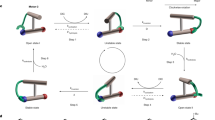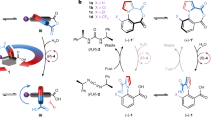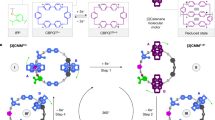Abstract
The conversion of chemical energy to drive directional motion at the molecular level allows biological systems, ranging from subcellular components to whole organisms, to perform a myriad of dynamic functions and respond to changes in the environment. Directional movement has been demonstrated in artificial molecular systems, but the fundamental motif of unidirectional rotary motion along a single-bond rotary axle induced by metal-catalysed transformation of chemical fuels has not been realized, and the challenge is to couple the metal-centred redox processes to stepwise changes in conformation to arrive at a full unidirectional rotary cycle. Here, we present the design of an organopalladium-based motor and the experimental demonstration of a 360° unidirectional rotary cycle using simple chemical fuels. Exploiting fundamental reactivity principles in organometallic chemistry enables control of directional rotation and offers the potential of harnessing the wealth of opportunities offered by transition-metal-based catalytic conversions to drive motion and dynamic functions.
This is a preview of subscription content, access via your institution
Access options
Subscribe to this journal
Receive 12 print issues and online access
$259.00 per year
only $21.58 per issue
Buy this article
- Purchase on Springer Link
- Instant access to full article PDF
Prices may be subject to local taxes which are calculated during checkout





Similar content being viewed by others
References
Champin, B., Mobian, P. & Sauvage, J.-P. Transition metal complexes as molecular machine prototypes. Chem. Soc. Rev. 36, 358–366 (2007).
Coskun, A., Banaszak, M., Astumian, R. D., Stoddart, J. F. & Grzybowski, B. A. Great expectations: can artificial molecular machines deliver on their promise? Chem. Soc. Rev. 41, 19–30 (2012).
Kay, E. R., Leigh, D. A. & Zerbetto, F. Synthetic molecular motors and mechanical machines. Angew. Chem. Int. Ed. 46, 72–191 (2006).
Browne, W. R. & Feringa, B. L. Making molecular machines work. Nature Nanotech. 1, 25–35 (2006).
Kinbara, K. & Aida, T. Toward intelligent molecular machines: directed motions of biological and artificial molecules and assemblies. Chem. Rev. 105, 1377–1400 (2005).
Balzani, V., Credi, A. & Venturi, M. Molecular Devices and Machines: Concepts and Perspectives for the Nanoworld (Wiley, 2008).
Koumura, N., Zijlstra, R. W. J., van Delden, R. A., Harada, N. & Feringa, B. L. Light-driven monodirectional molecular rotor. Nature 401, 152–155 (1999).
Koumura, N., Geertsema, E. M., van Gelder, M. B., Meetsma, A. & Feringa, B. L. Second generation light-driven molecular motors. Unidirectional rotation controlled by a single stereogenic centre with near-perfect photoequilibria and acceleration of the speed of rotation by structural modification. J. Am. Chem. Soc. 124, 5037–5051 (2002).
Leigh, D. A., Wong, J. K. Y., Dehez, F. & Zerbetto, F. Unidirectional rotation in a mechanically interlocked molecular rotor. Nature 424, 174–179 (2003).
Hernández, J. V., Kay, E. R. & Leigh, D. A. A reversible synthetic rotary molecular motor. Science 306, 1532–1537 (2004).
Bissell, R. A., Córdova, E., Kaifer, A. E. & Stoddart, J. F. A chemically and electronically switchable molecular shuttle. Nature 369, 133–137 (1994).
Ragazzon, G., Baroncini, M., Silvi, S., Venturi, M. & Credi, A. Light-powered autonomous and directional molecular motion of a dissipative self-assembling system. Nature Nanotech. 10, 70–75 (2015).
Von Delius, M., Geertsema, E. M. & Leigh, D. A. A synthetic small molecule that can walk down a track. Nature Chem. 2, 96–101 (2010).
Beves, J. E. et al. Toward metal complexes that can directionally walk along tracks: controlled stepping of a molecular biped with a palladium(II) foot. J. Am. Chem. Soc. 136, 2094–2100 (2014).
Kelly, T. R., De Silva, H. & Silva, R. A. Unidirectional rotary motion in a molecular system. Nature 401, 150–152 (1999).
Fletcher, S. P., Dumur, F., Pollard, M. M. & Feringa, B. L. A reversible unidirectional molecular rotary motor driven by chemical energy. Science 310, 80–82 (2005).
Bringmann, G. & Hartung, T. First atropenantioselective ring opening of an achiral lactone-bridged biaryl with chiral borane-derived hydride-transfer reagents. Angew. Chem. Int. Ed. Engl. 31, 761–762 (1992).
Bringmann, G. et al. Atropselective synthesis of axially chiral biaryl compounds. Angew. Chem. Int. Ed. 44, 5384–5427 (2005).
Kakiuchi, F., Le Gendre, P., Yamada, A., Ohtaki, H. & Murai, S. Atropselective alkylation of biaryl compounds by means of transition metal-catalyzed C–H/olefin coupling. Tetrahedron Asymmetr. 11, 2647–2651 (2000).
Ros, A. et al. Dynamic kinetic cross-coupling strategy for the asymmetric synthesis of axially chiral heterobiaryls. J. Am. Chem. Soc. 135, 15730–15733 (2013).
Bhat, V., Wang, S., Stoltz, B. M. & Virgil, S. C. Asymmetric synthesis of QUINAP via dynamic kinetic resolution. J. Am. Chem. Soc. 135, 16829–16832 (2013).
Hazra, C. K., Dherbassy, Q., Wencel-Delord, J. & Colobert, F. Synthesis of axially chiral biaryls through sulfoxide-directed asymmetric mild C–H activation and dynamic kinetic resolution. Angew. Chem. Int. Ed. 53, 13871–13875 (2014).
Leroux, F. R., Berthelot, A., Bonnafoux, L., Panossian, A. & Colobert, F. Transition-metal-free atropo-selective synthesis of biaryl compounds based on arynes. Chem. Eur. J. 18, 14232–14236 (2012).
Trost, B. M. & Rao, M. Development of chiral sulfoxide ligands for asymmetric catalysis. Angew. Chem. Int. Ed. 54, 5026–5043 (2015).
Clayden, J., Mitjans, D. & Youssef, L. H. Lithium–sulfoxide–lithium exchange for the asymmetric synthesis of atropisomers under thermodynamic control. J. Am. Chem. Soc. 124, 5266–5267 (2002).
Clayden, J., Fletcher, S. P., Rowbottom, S. J. M. & Helliwell, M. Conformational preferences of a polar biaryl: a phase- and enantiomeric purity-dependent molecular hinge. Org. Lett. 11, 2313–2316 (2009).
Lyons, T. W. & Sanford, M. S. Palladium-catalyzed ligand-directed C–H functionalization reactions. Chem. Rev. 110, 1147–1169 (2010).
Zalesskiy, S. S. & Ananikov, V. P. Pd2(dba)3 as a precursor of soluble metal complexes and nanoparticles: determination of palladium active species for catalysis and synthesis. Organometallics 31, 2302–2309 (2012).
Acknowledgements
This work was supported financially by the European Research Council (Advanced Investigator Grant no. 227897 to B.L.F.), The Netherlands Organization for Scientific Research (NWO-CW), funding from the Ministry of Education and Science (Gravitation programme 024.001.035) and The Royal Netherlands Academy of Arts and Sciences (KNAW).
Author information
Authors and Affiliations
Contributions
B.S.L.C. and B.L.F. conceived the project. B.S.L.C. performed the experimental work. J.C.M.K. performed the computational chemistry. E.O. solved the crystal structures. B.S.L.C. and B.L.F. wrote the manuscript. All authors read and commented on the manuscript.
Corresponding author
Ethics declarations
Competing interests
The authors declare no competing financial interests.
Supplementary information
Supplementary information
Supplementary information (PDF 5787 kb)
Supplementary information
Crystallographic data for compound (+-)-Pd[(R,M)-3]BrPCy3 (CIF 1871 kb)
Supplementary information
Crystallographic data for compound (S,M)-1 (CIF 843 kb)
Supplementary information
Crystallographic data for compound (S,P)-1 (CIF 1602 kb)
Rights and permissions
About this article
Cite this article
Collins, B., Kistemaker, J., Otten, E. et al. A chemically powered unidirectional rotary molecular motor based on a palladium redox cycle. Nature Chem 8, 860–866 (2016). https://doi.org/10.1038/nchem.2543
Received:
Accepted:
Published:
Issue Date:
DOI: https://doi.org/10.1038/nchem.2543
This article is cited by
-
Cation controlled rotation in anionic pillar[5]arenes and its application for fluorescence switch
Nature Communications (2023)
-
Catalytic asymmetric synthesis of sulfur-containing atropisomers by C-S bond formations
Science China Chemistry (2023)
-
Controlling forward and backward rotary molecular motion on demand
Nature Communications (2022)
-
Autonomous fuelled directional rotation about a covalent single bond
Nature (2022)
-
Insights from an information thermodynamics analysis of a synthetic molecular motor
Nature Chemistry (2022)



